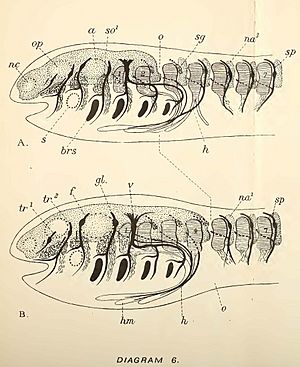Edwin Stephen Goodrich facts for kids
Edwin Stephen Goodrich was a famous English scientist who studied animals. He was born in 1868 and lived until 1946. He was an expert in many areas of zoology, which is the study of animals. This included looking at how animals' bodies are built (comparative anatomy), how they grow from tiny beginnings (embryology), studying ancient animals from fossils (palaeontology), and understanding how living things change over time (evolution). He was a professor at the University of Oxford for many years and also edited an important science journal.
His Life and Studies
Edwin Goodrich's father passed away when Edwin was just two weeks old. His mother then moved with her children to Pau, France, where Edwin went to both English and French schools. In 1888, he started studying art at the Slade School of Art in London. There, he met a scientist named E. Ray Lankester, who sparked his interest in zoology.
In 1891, Edwin moved to Oxford and continued his studies at Merton College, Oxford. He worked as an assistant to Lankester while studying zoology. He was a very good student and graduated with top honors in 1895.
In 1913, Edwin Goodrich married Helen Pixell, who was also a talented scientist studying tiny living things called protozoa. She helped him a lot with his work. Edwin was also a skilled artist. He drew beautiful and clear diagrams for his lectures and books. Students would even take pictures of his drawings on the blackboard because they were so good! He also showed his watercolor paintings in London. Edwin became a Fellow of the Royal Society in 1905, which is a big honor for scientists, and received a special medal in 1936. Many other science groups around the world also honored him.
His Work and Discoveries
When his mentor, E. Ray Lankester, became a professor at Oxford in 1892, he made Edwin Goodrich his assistant. This was the start of Edwin's research that made him one of the best comparative anatomists of his time. In 1921, Edwin took over Lankester's old job as a professor, which he held until 1945.
Edwin traveled a lot to study marine animals, visiting places like Plymouth, Naples, Bermuda, and the Canary Islands. He also explored parts of Europe, the United States, India, and Java.
One of his most important discoveries was about the tubes inside animals' bodies that connect to the outside. He found that there are two main types:
- Nephridia: These tubes develop from the outer part of the body inwards. They help animals get rid of waste, like a simple kidney.
- Coelomoducts: These tubes develop from the middle part of the body outwards. They are used to release germ cells, which are involved in reproduction.
Sometimes, these tubes can look similar, but Edwin showed they have different origins and main jobs. He explained why in humans, for example, the same system handles both waste removal and reproduction. Before his work, scientists were very confused about this.
Edwin also showed that a nerve connected to a muscle stays linked to that muscle, even if the muscle moves or changes during development. He also proved that body parts can be "homologous" (meaning they come from a common ancestor) even if they develop from different parts of the body in different animals. For example, the fins of fish and the limbs of mammals are homologous, even though they might grow from different body segments.
He also studied the scales of fish, both living and fossilized. He found that different types of fish scales can help scientists identify different layers of rock, which is useful for understanding Earth's history. Edwin was always very interested in evolution and strongly believed in natural selection, which is Charles Darwin's idea about how living things change over time.
In 1905, he was chosen as a Fellow of the Royal Society, a very respected group of scientists. On his 70th birthday in 1938, his friends and students published a special book of essays in his honor, celebrating his contributions to the study of evolution.
Images for kids





